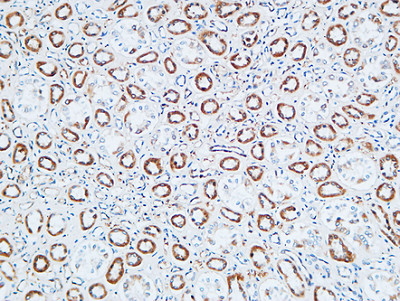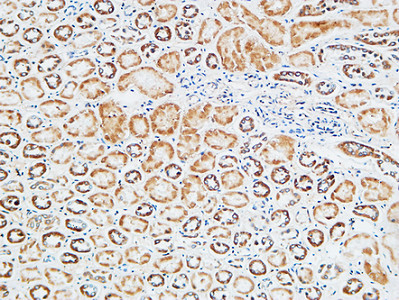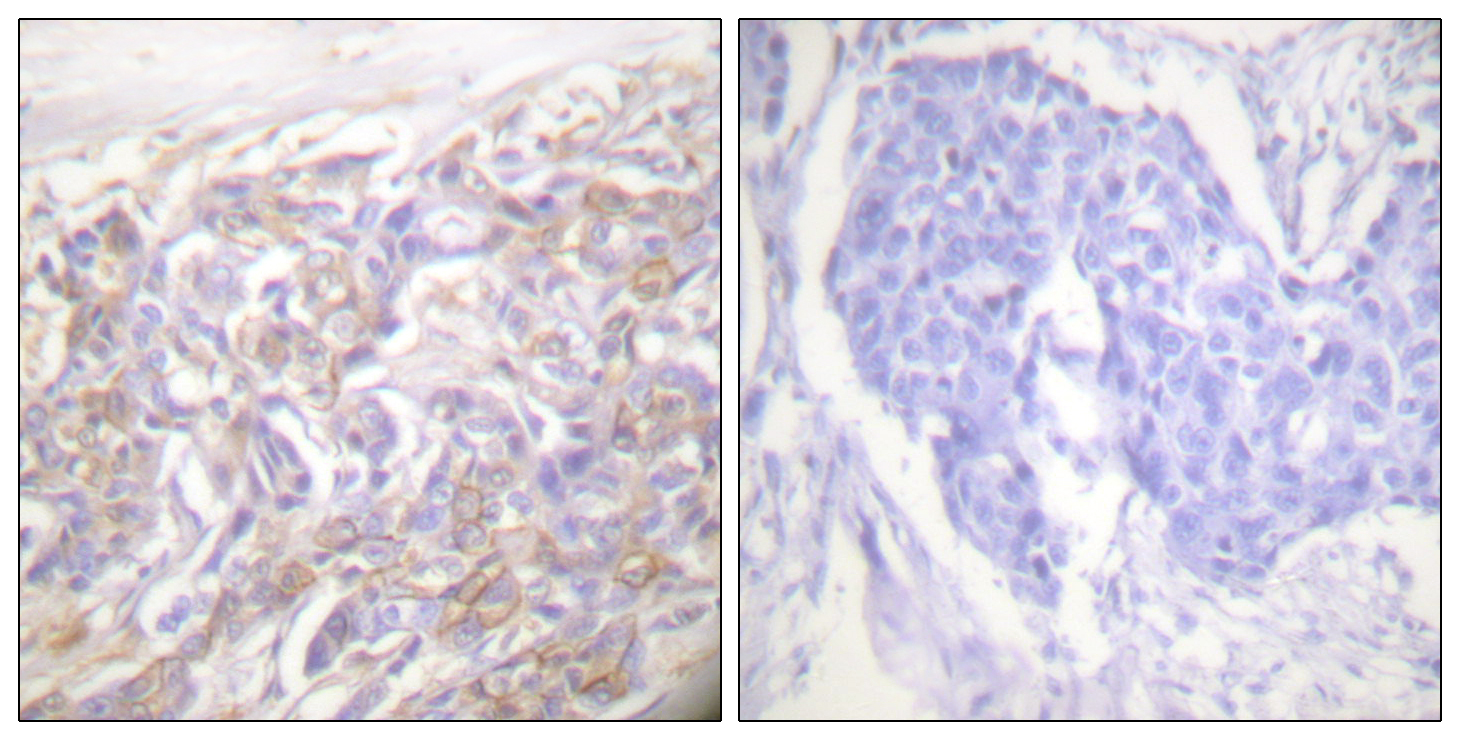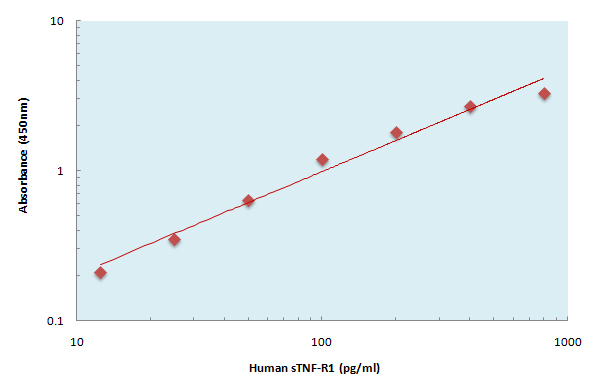TNF-R1 Polyclonal Antibody
- Catalog No.:YT4687
- Applications:IHC;IF;WB;ELISA
- Reactivity:Human;Mouse;Rat
- Target:
- TNF-R1
- Fields:
- >>MAPK signaling pathway;>>Cytokine-cytokine receptor interaction;>>Viral protein interaction with cytokine and cytokine receptor;>>NF-kappa B signaling pathway;>>Sphingolipid signaling pathway;>>mTOR signaling pathway;>>Apoptosis;>>Apoptosis - multiple species;>>Necroptosis;>>Osteoclast differentiation;>>TNF signaling pathway;>>Adipocytokine signaling pathway;>>Insulin resistance;>>Non-alcoholic fatty liver disease;>>Alcoholic liver disease;>>Alzheimer disease;>>Amyotrophic lateral sclerosis;>>Pathways of neurodegeneration - multiple diseases;>>Pathogenic Escherichia coli infection;>>Shigellosis;>>Salmonella infection;>>Chagas disease;>>Toxoplasmosis;>>Tuberculosis;>>Hepatitis C;>>Human cytomegalovirus infection;>>Influenza A;>>Human papillomavirus infection;>>Human T-cell leukemia virus 1 infection;>>Kaposi sarcoma-associated herpesvirus infection;>>Herpes simplex virus 1 infection;>>Human immunodeficiency virus 1 infection;>>Coronavirus disease - COVID-19;>>Lipid and atherosclerosis
- Gene Name:
- TNFRSF1A
- Protein Name:
- Tumor necrosis factor receptor superfamily member 1A
- Human Gene Id:
- 7132
- Human Swiss Prot No:
- P19438
- Mouse Gene Id:
- 21937
- Mouse Swiss Prot No:
- P25118
- Rat Gene Id:
- 25625
- Rat Swiss Prot No:
- P22934
- Immunogen:
- The antiserum was produced against synthesized peptide derived from human TNF Receptor I. AA range:381-430
- Specificity:
- TNF-R1 Polyclonal Antibody detects endogenous levels of TNF-R1 protein.
- Formulation:
- Liquid in PBS containing 50% glycerol, 0.5% BSA and 0.02% sodium azide.
- Source:
- Polyclonal, Rabbit,IgG
- Dilution:
- WB 1:500-2000 IHC 1:100 - 1:300. ELISA: 1:20000.. IF 1:50-200
- Purification:
- The antibody was affinity-purified from rabbit antiserum by affinity-chromatography using epitope-specific immunogen.
- Concentration:
- 1 mg/ml
- Storage Stability:
- -15°C to -25°C/1 year(Do not lower than -25°C)
- Other Name:
- TNFRSF1A;TNFAR;TNFR1;Tumor necrosis factor receptor superfamily member 1A;Tumor necrosis factor receptor 1;TNF-R1;Tumor necrosis factor receptor type I;TNF-RI;TNFR-I;p55;p60;CD antigen CD120a
- Observed Band(KD):
- 50kD
- Background:
- This gene encodes a member of the TNF receptor superfamily of proteins. The encoded receptor is found in membrane-bound and soluble forms that interact with membrane-bound and soluble forms, respectively, of its ligand, tumor necrosis factor alpha. Binding of membrane-bound tumor necrosis factor alpha to the membrane-bound receptor induces receptor trimerization and activation, which plays a role in cell survival, apoptosis, and inflammation. Proteolytic processing of the encoded receptor results in release of the soluble form of the receptor, which can interact with free tumor necrosis factor alpha to inhibit inflammation. Mutations in this gene underlie tumor necrosis factor receptor-associated periodic syndrome (TRAPS), characterized by fever, abdominal pain and other features. Mutations in this gene may also be associated with multiple sclerosis in human patients. [provided by Re
- Function:
- disease:Defects in TNFRSF1A are the cause of familial hibernian fever (FHF) [MIM:142680]; also known as tumor necrosis factor receptor-associated periodic syndrome (TRAPS). FHF is a hereditary periodic fever syndrome characterized by recurrent fever, abdominal pain, localized tender skin lesions and myalgia. Reactive amyloidosis is the main complication and occurs in 25% of cases.,domain:Both the cytoplasmic membrane-proximal region and the C-terminal region containing the death domain are involved in the interaction with TRPC4AP.,domain:The domain that induces A-SMASE is probably identical to the death domain. The N-SMASE activation domain (NSD) is both necessary and sufficient for activation of N-SMASE.,function:Receptor for TNFSF2/TNF-alpha and homotrimeric TNFSF1/lymphotoxin-alpha. The adapter molecule FADD recruits caspase-8 to the activated receptor. The resulting death-inducing si
- Subcellular Location:
- Cell membrane ; Single-pass type I membrane protein . Golgi apparatus membrane ; Single-pass type I membrane protein . Secreted . A secreted form is produced through proteolytic processing.; [Isoform 4]: Secreted. Lacks a Golgi-retention motif, is not membrane bound and therefore is secreted.
- Expression:
- Muscle,Neutrophil,Placenta,Teratocarcinoma,Tongue,Urine,Uterus,
Heat stress decreases egg production of laying hens by inducing apoptosis of follicular cells via activating the FasL/Fas and TNF-α systems. POULTRY SCIENCE Poultry Sci. 2020 Nov;99:6084 WB Hen 1 : 1000 Follicle
- June 19-2018
- WESTERN IMMUNOBLOTTING PROTOCOL
- June 19-2018
- IMMUNOHISTOCHEMISTRY-PARAFFIN PROTOCOL
- June 19-2018
- IMMUNOFLUORESCENCE PROTOCOL
- September 08-2020
- FLOW-CYTOMEYRT-PROTOCOL
- May 20-2022
- Cell-Based ELISA│解您多样本WB检测之困扰
- July 13-2018
- CELL-BASED-ELISA-PROTOCOL-FOR-ACETYL-PROTEIN
- July 13-2018
- CELL-BASED-ELISA-PROTOCOL-FOR-PHOSPHO-PROTEIN
- July 13-2018
- Antibody-FAQs
- Products Images

- Immunohistochemical analysis of paraffin-embedded Human kidney. 1, Antibody was diluted at 1:200(4° overnight). 2, High-pressure and temperature EDTA, pH8.0 was used for antigen retrieval. 3,Secondary antibody was diluted at 1:200(room temperature, 30min).

- Immunohistochemical analysis of paraffin-embedded Human kidney. 1, Antibody was diluted at 1:200(4° overnight). 2, High-pressure and temperature EDTA, pH8.0 was used for antigen retrieval. 3,Secondary antibody was diluted at 1:200(room temperature, 30min).

- Immunohistochemistry analysis of paraffin-embedded human breast carcinoma tissue, using TNF Receptor I Antibody. The picture on the right is blocked with the synthesized peptide.


